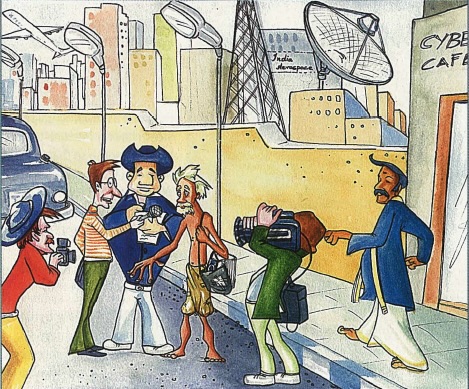By Francois Gautier
Foreign journalists and photographers covering India are generally interested in three kinds of India. First is the macabre and the negative: the widows of Benares, the caste system as practiced in Bihar, the rat temple, kidney traffic in Tamil Nadu, the slums of Calcutta, bride burning, etc. These subjects have their own truth and there do exist terrible slums, unacceptable exploitation of caste, dying people left unattended and bride burning. But by harping only on these topics, the foreign press always presents a strangely and unjustly negative image of India.
The second reporters’ India is that of folklore/myth and the superfluous: Maharajas, whom Westerners are charmed by, although they are mostly irrelevant to modern India; festivals, the camel fair, kumbha melas, dance performances in Khajuraho. All these have their own beauties, but they represent only a small part of this great and vast country.
The third is the politically correct. If you give the 300 foreign correspondents posted in Delhi a subject to write about–any subject–say Ayodhya, the RSS, fanatic Hindus, secularism or recent elections, you will get 298 articles which will say more or less the same thing. This is not to say that there are no sincere Western journalists who write serious stories which do homage to India’s greatness and immense culture, but they are rare. And at the end, the result is more or less the same: a downgrading of India, a constant harping on an anti-Christian “Hindu fundamentalism,” conveniently forgetting to mention that Christians have found refuge in this country for 2,000 years and have often taken advantage of this Hindu tolerance.
These three kinds of reporting about India have been going on for fifty years, and very few Indians have dared–or bothered–to complain. But the interesting question is: Why is the foreign press always harping on the negative, the folklore or the politically correct? Why this uniformity of views in a country which is so ancient, so diverse and profound that there are thousands of extraordinary topics which could be exploited?
The first reason is that the foreign correspondent comes to the job with narrowly fixed ideas about India. Then, we Western journalists are influenced by what is said about India in the “serious” books of distinguished Indologists, who have it all wrong: the supposed invasion of India by the Aryans (which never happened); the great achievements of the Moghul culture (borrowed from Hindu genius); the supposed fanaticism of Hindu social and political movements; the need for modern India to be “secular.” These historians have a very strong hold on the image of India abroad.
The second factor is simple: India is a vast and complicated country, often contradictory, full of paradoxes. The foreign correspondent turns for advice to his counterpart, the Indian journalist, who is frequently witty and well informed. And here lies the crux of the matter, because Indian journalists are often the worst enemies of their own country–they are more secular than the secular, more anti-India than its worst adversaries and often play the hands of India’s foes. We have then come into full circle: we thought that the Western press was negative about India, out of a personal bias, but we have found that it is influenced by the Indian press. We thought that the Indian press was negative about its own country, because of some dark, skeptical, self-destructive streak in itself, but we found out that it was a tendency generated by the Congress, which in turn was manipulated by its British masters. And thus, we have come full circle.
We have got to change the image of India. Who in the West wants to do business with a country with a backward image, one associated with slums and bureaucratic inefficiency? The Western press is not playing its true role of providing objective information. But that should not be a problem–look at China: less than thirty years ago it was considered in the West as the “Red Devil,” a feudal country, closed to the world. Then in 1971 Nixon went there and suddenly it became acceptable to do business in China. Today it enjoys in the West an image of a fast-forward, modern nation–although the Chinese killed a million Tibetans, gave Pakistan nuclear technology and still claims part of Indian territory. Many of us are trying to change India’s image abroad. But unless the Nehruvian legacy of bureaucracy and centralization is discarded, unless India starts looking at herself differently, unless its people have a little more pride in being Indian, there is very little we can do.
Francois Gautier,is correspondent in South Asia for Le Figaro, France’s largest circulated newspaper.


